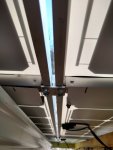Hey
@electrofelon how is your 2kV feeder is doing?
I am contemplating doing something like this for two rural water pumping projects with long feeders (1000').
I would need to keep it code compliant though.
Did you ever find a source for a 2kv transformer?
Cheers
Hey Tortuga, I do have some good information for you. I was investigating a 4000' step up step down scheme for someone else and I wanted it to be code compliant also, so I looked into some other options.
First of all, yes my setup is working awesome. Love it. Feel like I really got my moneys worth out of that 2KV PV wire making it work so hard

I got a few quotes for 15 KV transformers. One place quoted me ermcos for $1825, another was eaton for $2500. Now these were both standard 2400 voltage, but it sounded like the eaton ones were built to order, so perhaps the price for a 2KV is the same/similar.
Another thing I looked at was CIC cable assemblies. These were from southwire and will give you an idea on cost. Comes installed in 1 inch black schedule 40 pipe.
About 4000 feet CIC:
option #1: 2 - #10 AWG 2KV PV wire/RHH-2, and one #8 white THHN. $1.44 per ft
option #2: 2 - #8 AWG 2KV PV wire/RHH-2, and one #8 white THHN.
option #3: 2 - #8 5KV unshieled L-824 (airport lighting cable), and one #8 white THHN. $1.83 per ft
Note these have two ungrounded conductors because this job had two separately metered circuits. Option #2 did not come back with a price, I dont know why. There are still some potential code issues with these: Note that #8 is the minimum size for 2001-5000 volts. 0-2000V can be #14. The L-824 easily has the voltage rating for full 2400, but unshieded cables above 2000V have limited allowed use. All this really probably makes it worth staying with 2KV if full code compliance is needed.
A final option may be just to go with 15KV concentric neutral cable. Its only 2 bucks a foot for #2 AL. I would try to get it in CIC.
Thats 2KV Pv wire, transformer is 2400, tapped down all the way to 2280, close enough. I was too cheap to buy custom transformers. Runs about 500 feet to where it Tees into another 1900 foot line which goes from the service pedestal and transformer to the house.





